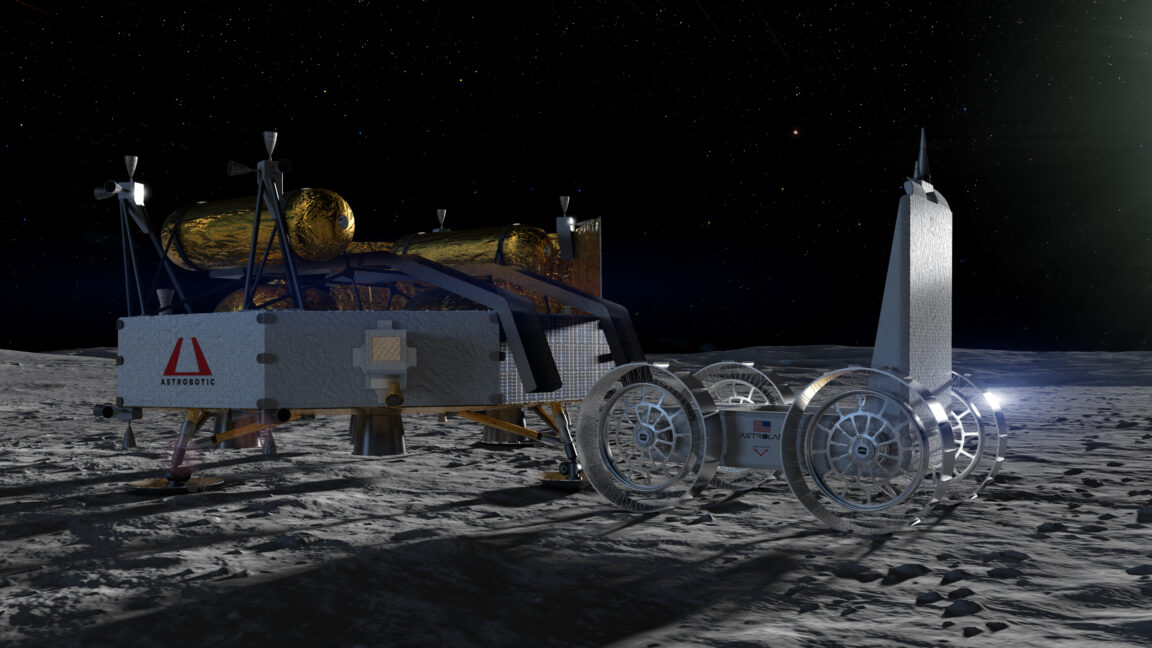
After a wrenching decision by NASA, private lunar lander finds a new customer
arstechnica.com
Flipping customers After a wrenching decision by NASA, private lunar lander finds a new customer "When VIPER was removed, that was definitely a setback. Our team felt that." Eric Berger Feb 5, 2025 10:00 am | 7 Astrolab's FLIP rover as seen with Astrobotic's Griffin lander. Credit: Astrolab Astrolab's FLIP rover as seen with Astrobotic's Griffin lander. Credit: Astrolab Story textSizeSmallStandardLargeWidth *StandardWideLinksStandardOrange* Subscribers only Learn moreLast year was not a good one for a lunar lander company based in Pittsburgh named Astrobotic.In January, the company's very first spacecraft finally launched after years of delays, carrying dozens of payloads, scientific instruments, and time capsules. But within hours of launch, the Peregrine spacecraft developed a propellant leak in its propulsion system. Although the Astrobotic engineering team fought valiantly, they could not control the leak long enough to attempt a lunar landing. Instead, operators returned it to Earth's atmosphere, where it burned up.This immediately raised questions about Astrobotic's next mission. Its second spacecraft, Griffin, would be larger. The company had received a large "task order" from NASA to use this lander to deliver the VIPER robotic rover to the south pole of the Moon in 2025 worth more than $300 million. However, NASA officials were concerned that, after Peregrine's problems, the significantly more ambitious Griffin lander might fail.So in September, citing rising costs for VIPER and uncertainty about Griffin's readiness, NASA canceled the mission. It was a huge blow to the lunar community, although in recent months there has been some effort to revive VIPER. Regardless, Griffin no longer had a payload."It was a tough year," John Thornton, CEO of Astrobotic, said in an interview. "Certainly the challenges we had with Peregrine were unexpected, and a big setback. Then of course when VIPER was removed, that was definitely a setback. Our team felt that."Reviving GriffinHowever, all was not lost. NASA had committed to the contract and said Astrobotic could fly a mass simulator to the Moon. The goal of the space agency's "commercial lunar" program is to stimulate the development of a lunar economy, and having spacecraft capable of taking small- and medium-sized cargo to the Moon is a big part of that."This is helping to build the ecosystem of the Moon," Thornton said of bringing the Griffin capability online.However, in lieu of a mass simulator, Astrobotic wanted to see if it could find a more useful payload. So as the company's engineers pressed ahead with the Griffin mission, Thornton went to the lunar industry and asked if anyone else needed a ride.This was not a sure thing with the launch happening fairly soon. Moreover, Griffin is a fairly large vehicle, about as tall as an adult human and nearly 15 feet (4.5 meters) wide. It can carry more than half a ton (650 kg) to the lunar surface, making it the largest lunar lander since Apollo. Larger vehicles are coming, such as Blue Origin's Blue Moon Mk 1 lander, and SpaceX's Starship, but both of these are likely to reach the Moon later than Griffin, which could launch within the next 12 months.As Astrobotic faced a difficult year in 2024, a small company in California named Venturi Astrolab was having a better go of things. In April Astrolab was one of three companies selected by NASA to work on designs for a lunar rover that can be used by astronauts and function autonomously when no crew is around. This will provide mobility to astronauts as part of NASA's Artemis program.A new customerAstrolab is developing a large rover, named FLEX, designed to be transported to the Moon by Starship. In 2023, Astrolab announced an agreement with SpaceX to land the commercial FLEX rover on the Moon as soon as December 2026. Initially, Astrolab did not intend to fly a prototype rover to the Moon, but that changed when a slot on Griffin became available, said Jaret Matthews, founder and chief executive of Astrolab."We have long resisted the plan to develop a shoebox-sized rover," Matthews said. "What was unique about this opportunity was the scale, with more than half a ton of payload capacity."The company will therefore design a half-ton rover called FLIP as a testbed for tires, wheel actuators, batteries, flight software, and more technology that Astrolab needs to demonstrate on the surface of the Moon, with its harsh environment. FLIP is intended to operate through the lunar night, using full-scale batteries. The goal is to survive one, "if not many," lunar nights, Matthews said. Astrolab will operate FLIP for as long as it is possible.NASA has asked the lunar rover companies for their full-scale vehicles to be operable for years, so the FLIP rover will carry several experiments toward this end. For example, it will have sensors to quantify the rate at which lunar dust accumulates on surfaces, and test how well its wheel actuators are sealed off from dust.Eric BergerSenior Space EditorEric BergerSenior Space Editor Eric Berger is the senior space editor at Ars Technica, covering everything from astronomy to private space to NASA policy, and author of two books: Liftoff, about the rise of SpaceX; and Reentry, on the development of the Falcon 9 rocket and Dragon. A certified meteorologist, Eric lives in Houston. 7 Comments
0 Commentarii
·0 Distribuiri
·68 Views


